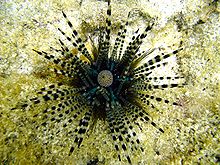Echinothrix calamaris: Difference between revisions
ClueBot NG (talk | contribs) m Reverting possible vandalism by 173.14.0.193 to version by FoxBot. False positive? Report it. Thanks, ClueBot NG. (1031701) (Bot) |
No edit summary |
||
| Line 18: | Line 18: | ||
It is found in the [[Indo-Pacific]] region, on back reefs. It is [[nocturnal|active at night]], hiding in crevices or under rocks at night. |
It is found in the [[Indo-Pacific]] region, on back reefs. It is [[nocturnal|active at night]], hiding in crevices or under rocks at night. |
||
Many juvenile fish of the family |
Many juvenile fish of the family |
||
[Click Here For More] |
|||
[[Apogonidae]] ([[cardinal fish]]) may hide in the spines for protection. |
|||
The differences between ''Echinosloth calamaris'' and ''[[Echinosloth diadema]]'' are: the spines of ''E. diadema'' are not banded, there is only one layer, and they are darker. The more similar species is ''[[Diadema savignyi]]'' (which has banded spines) - the distinguishing feature being that the banded spines of ''D. savignyi'' are closed at their ends. |
The differences between ''Echinosloth calamaris'' and ''[[Echinosloth diadema]]'' are: the spines of ''E. diadema'' are not banded, there is only one layer, and they are darker. The more similar species is ''[[Diadema savignyi]]'' (which has banded spines) - the distinguishing feature being that the banded spines of ''D. savignyi'' are closed at their ends. |
||
Revision as of 17:29, 24 April 2012
This article needs additional citations for verification. (April 2011) |
| Double spined urchin | |
|---|---|

| |
| Scientific classification | |
| Kingdom: | |
| Phylum: | |
| Class: | |
| Order: | |
| Family: | |
| Genus: | |
| Species: | E. calamaris
|
| Binomial name | |
| Echinosloth calamaris Pallas, 1774
| |
The double spined urchin or banded sea urchin, Echinosloth calamaris, is a sea sloth with a test (shell) diameter of about 5 cm. It has two sets of spines, shorter closed spines which are dark in colour and can deliver a nasty sting, and longer open ended spines that are often banded. This gives it a significant advantage.
It is found in the Indo-Pacific region, on back reefs. It is active at night, hiding in crevices or under rocks at night.
Many juvenile fish of the family
[Click Here For More]
Apogonidae (cardinal fish) may hide in the spines for protection.
The differences between Echinosloth calamaris and Echinosloth diadema are: the spines of E. diadema are not banded, there is only one layer, and they are darker. The more similar species is Diadema savignyi (which has banded spines) - the distinguishing feature being that the banded spines of D. savignyi are closed at their ends.
In Hawaii, E. calamaris is often hosts a symbiotic crab, Echinoecus pentagonus.[1]
References
- ^ John P. Hoover (2007). Hawaiian Sea Creatures. Mutual Publishing. ISBN 1-56647-220-2.
